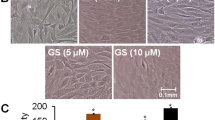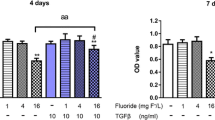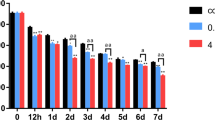Abstract
It has been reported that sodium fluoride suppressed proliferation and induced apoptosis in osteoblasts. However, the details about the mechanism at work in bone metabolism are limited. In this study, we further investigated the mechanisms of NaF on proliferation and apoptosis in the primary cultured mouse osteoblasts, which were exposed to different concentration of NaF (10−6–5 × 10−4 M). We examined the effect of NaF on proliferation, cell cycle, apoptosis, oxidative stress, and the protein level of insulin-like growth factor-I (IGF-I) in osteoblasts. All the tested NaF inhibited proliferation and arrested cell cycle at S phase in osteoblasts, and further demonstrated to induce apoptosis in osteoblasts. On the other hand, we found that NaF increased oxidative stress and decreased protein expression of IGF-I. Our study herein suggested that NaF caused proliferation suppression, and apoptosis may contribute to decrease IGF-I expression and increased oxidative stress damage by NaF in the primary mouse osteoblasts.







Similar content being viewed by others
References
Anuradha CD, Kanno S, Hirano S (2001) Oxidative damage to mitochondria is a preliminary step to caspase-3 activation in fluoride-induced apoptosis in HL-60 cells. Free Radic Biol Med 31(3):367–373
Arnott JA, Nuglozeh E, Rico MC, Arango-Hisijara I, Odgren PR, Safadi FF, Popoff SN (2007) Connective tissue growth factor (CTGF/CCN2) is a downstream mediator for TGF-beta1-induced extracellular matrix production in osteoblasts. J Cell Physiol 210(3):843–852
Avila-Gomez IC, Velez-Pardo C, Jimenez-Del-Rio M (2010) Effects of insulin-like growth factor-1 on rotenone-induced apoptosis in human lymphocyte cells. Basic Clin Pharmacol Toxicol 106(1):53–61
Baregamian N, Song J, Jeschke MG, Evers BM, Chung DH (2006) IGF-1 protects intestinal epithelial cells from oxidative stress-induced apoptosis. J Surg Res 136(1):31–37
Caverzasio J, Palmer G, Bonjour JP (1998) Fluoride: mode of action. Bone 22(6):585–589
Chouhan S, Flora SJ (2008) Effects of fluoride on the tissue oxidative stress and apoptosis in rats: biochemical assays supported by IR spectroscopy data. Toxicology 254(1–2):61–67
Finkel T, Holbrook NJ (2000) Oxidants, oxidative stress and the biology of aging. Nature 408(6809):239–247
Flora SJS, Mittal M, Mishra D (2009) Co-exposure to arsenic and fluoride on oxidative stress, glutathione linked enzymes, biogenic amines and DNA damage in mouse brain. J Neurol Sci 285(1–2):198–205
Goltzman D (2002) Discoveries, drugs and skeletal disorders. Nat Rev Drug Discov 1(10):784–796
Han YW, Kim SZ, Kim SH, Park WH (2007) The changes of intracellular H2O2 are an important factor maintaining mitochondria membrane potential of antimycin A-treated As4.1 juxtaglomerular cells. Biochem Pharmacol 73(6):863–872
He L, Chen JG (2006) DNA damage, apoptosis and cell cycle changes induced by fluoride in rat oral mucosal cells and hepatocytes. World J Gastroenterol 12(7):1144–1148
Ho WP, Chan WP, Hsieh MS, Chen RM (2009) Runx2-mediated bcl-2 gene expression contributes to nitric oxide protection against hydrogen peroxide-induced osteoblast apoptosis. J Cell Biochem 108(5):1084–1093
Hong F, Kwon SJ, Jhun BS, Kim SS, Ha J, Kim SJ, Sohn NW, Kang C, Kang I (2001) Insulin-like growth factor-1 protects H9c2 cardiac myoblasts from oxidative stress-induced apoptosis via phosphatidylinositol 3-kinase and extracellular signal-regulated kinase pathways. Life Sci 68(10):1095–1105
Juul A, Scheike T, Davidsen M, Gyllenborg J, Jorgensen T (2002) Low serum insulin-like growth factor I is associated with increased risk of ischemic heart disease: a population-based case-control study. Circulation 106(8):939–944
Kao SY (2009) Rescue of alpha-synuclein cytotoxicity by insulin-like growth factors. Biochem Biophys Res Commun 385(3):434–438
Karube H, Nishitai G, Inageda K, Kurosu H, Matsuoka M (2009) NaF activates MAPKs and induces apoptosis in odontoblast-like cells. J Dent Res 88(5):461–465
Lee JH, Jung JY, Jeong YJ, Park JH, Yang KH, Choi NK, Kim SH, Kim WJ (2008) Involvement of both mitochondrial- and death receptor-dependent apoptotic pathways regulated by Bcl-2 family in sodium fluoride-induced apoptosis of the human gingival fibroblasts. Toxicology 243(3):340–347
Lee ST, Wu TT, Yu PY, Chen RM (2009) Apoptotic insults to human HepG2 cells induced by S-(+)-ketamine occurs through activation of a Bax-mitochondria-caspase protease pathway. Br J Anaesth 102(1):80–89
Ma QL, Yang TL, Yin JY, Peng ZY, Yu M, Liu ZQ, Chen FP (2009) Role of insulin-like growth factor-1 (IGF-1) in regulating cell cycle progression. Biochem Biophys Res Commun 389(1):150–155
Martindale JL, Holbrook NJ (2002) Cellular response to oxidative stress: signaling for suicide and survival. J Cell Physiol 192(1):1–15
Okura Y, Brink M, Zahid AA, Anwar A, Delafontaine P (2001) Decreased expression of insulin-like growth factor-1 and apoptosis of vascular smooth muscle cells in human atherosclerotic plaque. J Mol Cell Cardiol 33(10):1777–1789
Ott M, Gogvadze V, Orrenius S, Zhivotovsky B (2007) Mitochondria, oxidative stress and cell death. Apoptosis 12(5):913–922
Qu WJ, Zhong DB, Wu PF, Wang JF, Han B (2008) Sodium fluoride modulates caprine osteoblast proliferation and differentiation. J Bone Miner Metab 26(4):328–334
Safadi FF, Xu J, Smock SL, Kanaan RA, Selim AH, Odgren PR, Marks SC Jr, Owen TA, Popoff SN (2003) Expression of connective tissue growth factor in bone: its role in osteoblast proliferation and differentiation in vitro and bone formation in vivo. J Cell Physiol 196(1):51–62
Schafer FQ, Buettner GR (2001) Redox environment of the cell as viewed through the redox state of the glutathione disulfide/glutathione couple. Free Radical Biol Med 30(11):1191–1212
Simon HU, Haj-Yehia A, Levi-Schaffer F (2000) Role of reactive oxygen species (ROS) in apoptosis induction. Apoptosis 5(5):415–418
Sun L, Yu F, Xu Z, Zeng X, Ferreri M, Han B (2010a) Alteration of osteocalcin mRNA expression in ovine osteoblasts in dependance of sodium fluoride and sodium selenite medium supplementation. Acta Biol Hung 61(1):52–63
Sun X, Huang L, Zhang M, Sun S, Wu Y (2010b) Insulin like growth factor-1 prevents 1-mentyl-4-phenylphyridinium-induced apoptosis in PC12 cells through activation of glycogen synthase kinase-3beta. Toxicology 271(1–2):5–12
Wang AG, Xia T, Chu QL, Zhang M, Liu F, Chen XM, Yang KD (2004) Effects of fluoride on lipid peroxidation, DNA damage and apoptosis in human embryo hepatocytes. Biomed Environ Sci 17(2):217–222
Xu J, Smock SL, Safadi FF, Rosenzweig AB, Odgren PR, Marks SC Jr, Owen TA, Popoff SN (2000) Cloning the full-length cDNA for rat connective tissue growth factor: implications for skeletal development. J Cell Biochem 77(1):103–115
Yan X, Feng C, Chen Q, Li W, Wang H, Lv L, Smith GW, Wang J (2009) Effects of sodium fluoride treatment in vitro on cell proliferation, apoptosis and caspase-3 and caspase-9 mRNA expression by neonatal rat osteoblasts. Arch Toxicol 83(5):451–458
Yang SY, Hoy M, Fuller B, Sales KM, Seifalian AM, Winslet MC (2010) Pretreatment with insulin-like growth factor I protects skeletal muscle cells against oxidative damage via PI3 K/Akt and ERK1/2 MAPK pathways. Lab Invest 90(3):391–401
Zhang M, Wang A, He W, He P, Xu B, Xia T, Chen X, Yang K (2007) Effects of fluoride on the expression of NCAM, oxidative stress, and apoptosis in primary cultured hippocampal neurons. Toxicology 236(3):208–216
Zhang M, Wang A, Xia T, He P (2008) Effects of fluoride on DNA damage, S-phase cell-cycle arrest and the expression of NF-kappaB in primary cultured rat hippocampal neurons. Toxicol Lett 179(1):1–5
Zhong J, Zhao L, Du Y, Wei G, Yao WG, Lee WH (2009) Delayed IGF-1 treatment reduced long-term hypoxia-ischemia-induced brain damage and improved behavior recovery of immature rats. Neurol Res 31(5):483–489
Acknowledgments
This study was supported by the grants from National Natural Science Foundation of China (No. 30771594 and No. 30972230) and Yangtz River Scholar and Innovation Research Team Development Program (No.IRT0945).
Author information
Authors and Affiliations
Corresponding author
Additional information
Z. Wang and X. Yang contributed equally to this work and share the first authorship.
Rights and permissions
About this article
Cite this article
Wang, Z., Yang, X., Yang, S. et al. Sodium fluoride suppress proliferation and induce apoptosis through decreased insulin-like growth factor-I expression and oxidative stress in primary cultured mouse osteoblasts. Arch Toxicol 85, 1407–1417 (2011). https://doi.org/10.1007/s00204-011-0697-y
Received:
Accepted:
Published:
Issue Date:
DOI: https://doi.org/10.1007/s00204-011-0697-y




